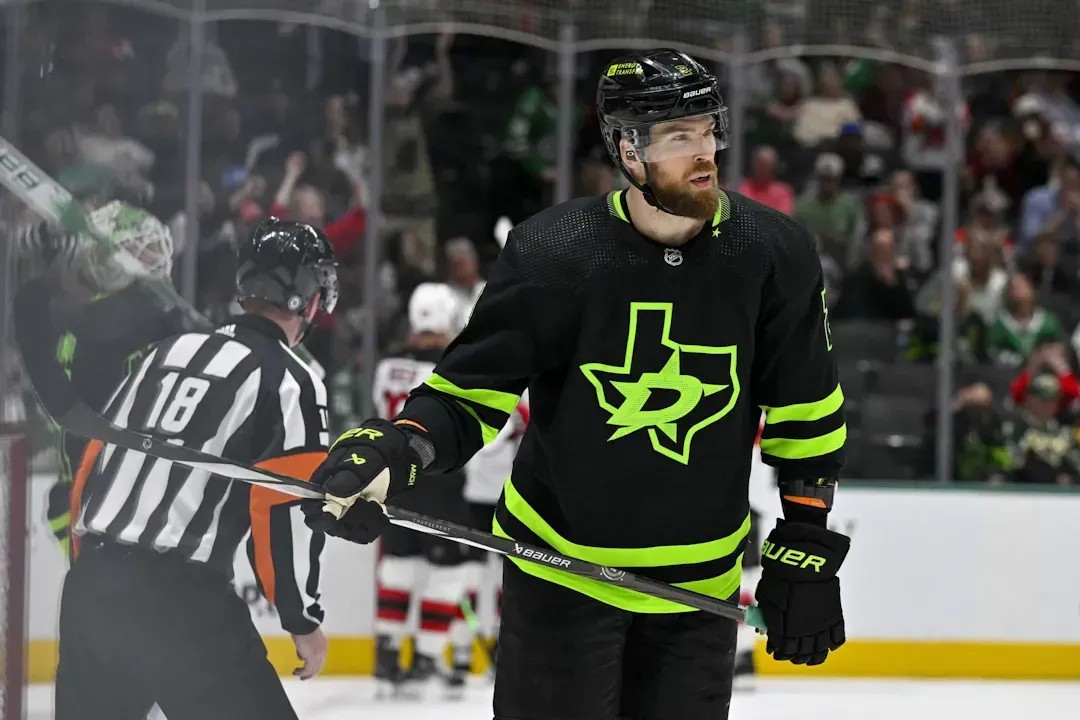The oddest Toronto Maple Leafs saga of the summer concluded today, as the Leafs officially agreed to a one-year, $1.47 million contract with defenseman Jani Hakanpää.
If this sounds familiar, it’s because it is. The Leafs reportedly agreed to a 2x$1.5m contract with Hakanapää on July 1, but the team never officially announced the deal. Speculation about the severity of the knee injury that ended Hakanapää’s 2023-24 campaign was said to be the hangup, as the Leafs presumably reviewed Hakanapää’s medical records. After months of deliberation, the team appears to be comfortable enough with Hakanapää’s health to give him a contract, albeit with one fewer year and slightly fewer dollars than initially reported:
🖊 We’ve signed defenceman Jani Hakanpää to a one-year contract
— Toronto Maple Leafs (@MapleLeafs) September 11, 2024
Hakanpaa’s Profile & Potential Fit
The first thing to know about the Finnish defenseman is that he is massive, officially listed on Hockey Reference at 6’6, 225 lbs.
Hakanpää was originally a mid-round draft pick of St. Louis back in 2010 but didn’t reach the NHL for a decade. He played in his native Finland up through 2013, gave it a try in North America but couldn’t get past the AHL, and then returned for four seasons in the Finnish Liiga with Oulun Kärpät. After establishing himself as one of the best defensemen in Finland, the Anaheim Ducks signed Hakanpää in the summer of 2019, with his rights long since relinquished by the Blues.
Hakanpää spent his first season back in North America primarily in the AHL, although he did get his first taste of NHL action in six games that 2019-20 season. His first full season in the NHL came the following year, 2020-21, at age 28/29. Hakanpää managed a bit of a rarity that year, playing more than the maximum number of games in the season by dressing 57 games in a 56-game season. The trick was playing 42 games for Anaheim before a trade to Carolina, where he played the final 15 games of the Hurricanes’ season. Hakanpää proved himself to be a decent defensive defenseman and heavily used PKer who added almost nothing offensively in his first NHL season, scoring four total points (a pair of goals and two assists). He made the Hurricanes’ playoff lineup, playing 11 postseason games with no points.
That trial was enough to parlay Hakanpää into a lucrative contract with Dallas, signing three-year UFA papers with the Stars in the summer of 2021. After playing a pretty sheltered role in 2021-22 (16:13 per night), Hakanpää grew into larger responsibility, logging 19:20 last season and 18:39 in the most recently concluded season. With the surge in ice time came an increase in points, 12 in ’22, 16 in ’23, and 12 in ’24 — still not very many, as Hakanpää remains an all-defense defenseman with very limited puck-moving ability. However, growing into a defender who can shoulder a more significant workload is notable as we look at how the Leafs could choose to use Hakanpää in Toronto. He was generally good for #4-5 usage at 5v5 and massive PK responsibilities in Dallas.
The official signing of Hakanpää is yet an example of Brad Treliving making good on his vow to add size on defense as the GM of the Maple Leafs. His acquisitions of Joel Edmundson and Ilya Lyubushkin at the trade deadline served as an example, as did signing Chris Tanev earlier this summer. Now, in inking Hakanpää, Treliving secures his biggest mammoth yet. Hakanpää defends in the zone well, hence his PK prowess, and shows decently defending entries, but there is almost no play with the puck here. It’s a limited profile, but given the Leafs‘ lack of size beforehand and the chronic issues with their penalty kill last season, it isn’t an illogical add.
With a healthy Hakanpaa, the Leafs would own a nice balance amongst their top seven defensemen in terms of handedness, skill, physicality, and defensive prowess. A healthy Hakanpaa would instantly become their second or third-best penalty killer behind Tanev and maybe Jake McCabe, either playing on the top unit or driving the second unit. For a Leafs penalty kill that finished 23rd last season, it’s an important addition. They can’t ask Tanev to do it all, and frankly, at Tanev’s age, an option like Hakanpaa (if healthy) to spell Tanev throughout an 82-game season is a valuable resource.
Hakanpaa is a defensive specialist, largely used in difficult minutes with tons of defensive zone faceoffs and penalty killing. He isn’t going to offer much offensively, and he generally hasn’t moved the puck well enough to be a full-fledged top-four. But he plays his role well. He’s essentially a bigger, more mature, and right-handed version of what Simon Benoit ideally becomes.
That meshes well with the OEL acquisition as, ideally, OEL is deployed in the exact opposite manner. In Florida, OEL started in the offensive zone 57.65 percent of the time, the highest mark of his career. In his first season in Vancouver, he recorded the lowest offensive zone start percentage of his career and – not coincidentally – the lowest points per game output of his career. He is an offense-first player – which is fine; it’s a huge need for the Leafs – but it’s fair to question if he’s a well-rounded, full-on, top-four defenseman at this point. He’s coming off his lowest time on ice per game season since his rookie year 13 seasons ago, and he played under 16 minutes per game in the playoffs. This all means the Leafs need enough quality elsewhere to best optimize OEL.
The elephant in the room
Of course, the major unknown is Hakanpää’s health situation.
It’s worth noting that over the course of his time in the NHL since returning to North America, Hakanpää has generally been extremely healthy. We already detailed his 57-game feat in 2021, but he followed that up with 80 and 82 games in Dallas in 2022 and 2023. That was derailed this past season, despite starting 2023-24 by playing in 64 of his team’s first 69 games.
Hakanpää suffered an injury in mid-March that was described as the ol’ “lower-body injury” at the time, but after Dallas’ playoff run ended, the team clarified that it was a knee ailment that required an arthroscopic procedure. That was concerning at face value, but then reports came out (albeit from dubious source Steve Simmons) that teams around the league believed Hakanpää was unlikely to ever play in the NHL again due to the severity of the knee injury.
While Simmons was the first source, Chris Johnston echoed similar concerns during an August podcast. Johnston stated that some believe there to be little cartilage remaining in Hakanpää’s knee, which could make playing extremely painful. However, he did note at that time that Hakanpää believed he could still play on the knee. Given that he signed the contract today, it would seem that Hakanpää believes he can give one more go at this, or at least wants to.
In all, there seems to be a significant medical risk with Hakanpää, which was probably apparent in July when it was reported that he had signed for a much lower AAV than Joel Edmundson had received in Los Angeles. However, for a wealthy team that can afford to pay the bill of any players who wind up on LTIR, it’s fairly viewed as a worthwhile risk because the upside is certainly significant.
If Hakanpää could get back to something resembling his old form, he fills a lot of needs for the Maple Leafs: a physical, right-shot defenseman with good size who plays real minutes on the penalty kill, which was the team’s biggest weakness last season. For only $1.47m against the cap, it would be very savvy if it works out. Given the potentially grim injury situation, it very well might not.
If we assume that Hakanpää is healthy and able to start the season on the roster over LTIR, he joins camp as part of a very crowded Maple Leafs defensive depth chart. The team now has eight defensemen signed for the upcoming season: Morgan Rielly, Chris Tanev, Oliver Ekman-Larsson, Timothy Liljegren, Jake McCabe, Simon Benoit, Jani Hakanpää, and Conor Timmins.
One would expect Rielly, Tanev, OEL, and McCabe to be locks for the nightly roster. That leaves four defensemen to fill the final two holes in the lineup, three of whom are right-handed: Liljegren, Hakanpää, Benoit, and Timmins. The righties each bring something different to the lineup: Liljegren’s two-way transition game, Timmins’ aggressive offensive profile and PP abilities, and Hakanpää’s size, defense, and PK ability. That would give coach Craig Berube a nice collection of options to play with, although it’s unlikely all eight will make the opening roster, given salary cap constraints.
The cap situation is tough to project at this time, with so many moving parts and two legitimate NHL forwards on PTOs (Steven Lorentz and Max Pacioretty) attending camp. If Hakanpää can play, the team is $1.1 million over the cap even without Pacioretty signed, so something would have to give. As part of the crunch, it’s difficult to foresee Timmins not hitting the waiver wire or moving out to help make the cap books work, barring injury/injuries or something drastic changing at camp. From there, if they want to sign Pacioretty, it would require moving out another player.
with notes from Anthony Petrielli and Alec Brownscombe













![John Gruden after the Leafs prospects’ 4-1 win over Montreal: “[Vyacheslav Peksa] looked really comfortable in the net… We wouldn’t have won without him” John Gruden, head coach of the Toronto Marlies](https://mapleleafshotstove.com/wp-content/uploads/2025/09/gruden-post-game-sep-14-218x150.jpg)


















